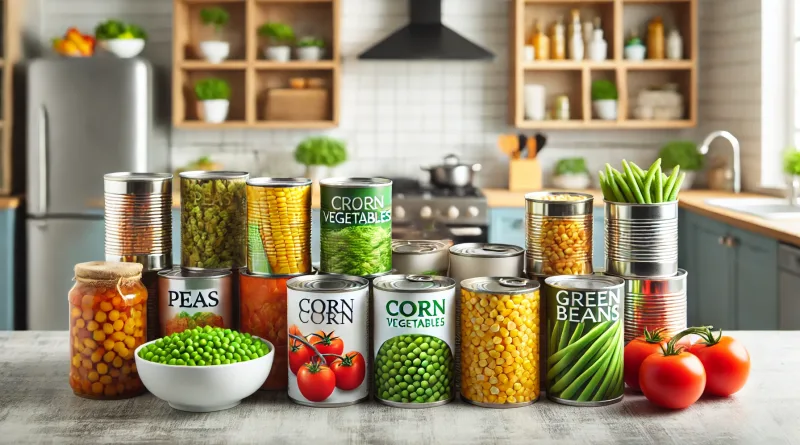Frozen and Canned Produce: Are They Just as Nutritious as Fresh?
When it comes to fruits and vegetables, many people believe that fresh is always best. This common perception leads to the assumption that frozen and canned produce is inferior in terms of nutritional value. However, this is not always the case. In fact, frozen and canned options can be just as nutritious as their fresh counterparts, provided they are packaged without unhealthy additives like salt or syrup. This article explores the nutritional benefits of frozen and canned produce and offers insights on how to choose the best options for a healthy diet.
The Nutritional Value of Fresh Produce
Fresh fruits and vegetables are often lauded for their high nutrient content. They are rich in vitamins, minerals, antioxidants, and fiber, all of which are essential for maintaining good health. However, the nutritional value of fresh produce can degrade over time. From the moment fruits and vegetables are harvested, they begin to lose nutrients. The time it takes for fresh produce to travel from the farm to your table can significantly impact its nutritional quality.
How Freezing Preserves Nutrients
Frozen produce is typically processed very soon after harvest, often within hours. This quick transition from field to freezer helps lock in nutrients that might otherwise degrade. The freezing process involves blanching vegetables (briefly boiling them before freezing) to destroy enzymes that can cause spoilage. This process helps maintain the nutritional value, texture, and flavor of the produce.
In many cases, frozen fruits and vegetables retain more nutrients than fresh produce that has been stored for several days or transported over long distances. For instance, studies have shown that frozen peas and spinach can have higher levels of vitamin C compared to their fresh-stored counterparts.
The Benefits of Canned Produce
Canned fruits and vegetables also offer a convenient and nutritious option, especially when fresh produce is not available. The canning process involves heating the produce to destroy bacteria and seal it in airtight containers, which helps preserve its nutritional value. Similar to freezing, canning is often done shortly after harvest, ensuring that the produce is at its peak ripeness and nutritional content.
One of the main concerns with canned produce is the potential addition of unhealthy additives such as salt, sugar, or syrup. However, many brands offer low-sodium or no-salt-added vegetables and fruits packed in their own juice or water, which can be just as healthy as fresh produce.
Comparing Nutritional Content
To better understand the nutritional differences between fresh, frozen, and canned produce, let’s compare some common examples:
- Peas: Fresh peas may lose up to 51% of their vitamin C content within 24 to 48 hours after harvest. Frozen peas, on the other hand, can retain most of their vitamin C for months. Canned peas generally retain a significant amount of nutrients but may contain added salt.
- Spinach: Fresh spinach loses about 90% of its vitamin C within 24 hours of harvest if not stored properly. Frozen spinach retains its vitamin C content well, while canned spinach can still be a good source of vitamin A and iron, despite potential sodium content.
- Tomatoes: Fresh tomatoes are rich in lycopene, a powerful antioxidant. Canned tomatoes often have higher lycopene content than fresh ones due to the heating process used in canning, which makes lycopene more bioavailable.
Tips for Choosing the Best Frozen and Canned Produce
- Check Labels: When purchasing frozen or canned produce, always read the labels. Look for products without added salt, sugar, or preservatives.
- Opt for Whole Foods: Choose whole fruits and vegetables rather than those in sauces or syrups.
- Consider Convenience: Frozen and canned produce can be a convenient option for meal prep and reducing food waste, especially for busy lifestyles.
- Mix It Up: Incorporate a variety of fresh, frozen, and canned produce into your diet to ensure a diverse intake of nutrients.
Detailed Nutrient Comparison Table
To provide a clearer picture of the nutritional differences between fresh, frozen, and canned produce, let’s compare some common fruits and vegetables. The following table includes data on the vitamin C content, fiber content, and overall nutrient retention for peas, spinach, and tomatoes.
| Produce | Form | Vitamin C (mg per 100g) | Fiber (g per 100g) | Notes on Nutrient Retention |
|---|---|---|---|---|
| Peas | Fresh | 40 mg | 5.1 g | Nutrients start to degrade within 24-48 hours after harvest. |
| Frozen | 35 mg | 4.9 g | Retains most nutrients due to quick freezing after harvest. | |
| Canned | 15 mg | 4.7 g | Good retention of fiber, may have added salt. | |
| Spinach | Fresh | 28 mg | 2.2 g | Loses about 90% of vitamin C within 24 hours if not stored properly. |
| Frozen | 25 mg | 2.1 g | Retains most vitamin C, high in vitamin A and K. | |
| Canned | 13 mg | 2.0 g | Still a good source of vitamin A and iron, possible added sodium. | |
| Tomatoes | Fresh | 20 mg | 1.2 g | High in lycopene when ripe. |
| Frozen | 18 mg | 1.1 g | Good retention of lycopene and vitamin C. | |
| Canned | 10 mg | 1.0 g | Higher bioavailability of lycopene due to heating process. |
Frozen and canned produce can be just as nutritious as fresh, especially when chosen carefully. These options offer convenience, reduced food waste, and year-round availability of a wide range of fruits and vegetables. By selecting products without unhealthy additives and incorporating them into a balanced diet, you can enjoy the health benefits of fruits and vegetables regardless of their form.




